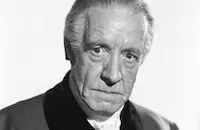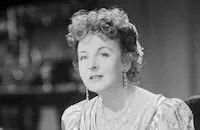The Prisoner of Zenda

Brief Synopsis
Cast & Crew
Richard Thorpe
Stewart Granger
Deborah Kerr
Louis Calhern
Jane Greer
Lewis Stone
Film Details
Technical Specs

Synopsis
In 1897, while visiting a small European country, Englishman Rudolf "Rudy" Rassendyll stops for a nap in the forest and is seen by Col. Zapt and Fritz von Tarlenheim, who are startled by his remarkable similarity to their king, Rudolf V. When the king arrives moments later, he and Rudy laugh at their resemblance, which Zapt speculates is due to a "royal scandal" several generations past. Rudolf, who is to be crowned the next day and will soon marry his cousin, Princess Flavia, invites Rudy to stay at his hunting lodge that night. True to his reputation as a wastrel and drunkard, Rudolf drinks too much at dinner, prompting Zapt to remind him of his duty. Rudolf slaps Zapt, but as soon as the colonel withdraws, Rudolf regrets his action. Before another bottle of wine is brought, Rudy falls asleep, and the king drinks alone. The next morning, when Zapt goes into the dining room, he finds Rudy asleep and the king unconscious. Zapt deduces that a drugging was arranged by Rudolf's illegitimate half-brother Michael, Duke of Strelsau, and tells Rudy that if the coronation does not take place that day, Michael will proclaim Rudolf unfit to rule and seize the throne. Convinced that fate has brought Rudy to his country, Zapt urges him to take the king's place at the coronation. After shaving his moustache, darkening his graying temples and donning Rudolf's monocle, Rudy is an exact double for the king. He then accompanies Zapt and Fritz to the coronation while the comatose Rudolf is safely locked in his bedroom. Meanwhile, Michael signs a proclamation that will make him king after Rudolf fails to appear for his coronation. Although his devoted mistress, Antoinette de Mauban, begs him not to seize power, Michael refuses to be dissuaded. Unknown to Michael, Antoinette is desired by his ambitious ally, Rupert of Hentzau, who warns her that Michael can only secure his crown by marrying Flavia. Later, at the cathedral, Rupert and Michael patiently wait, sure that the coronation will not take place, then are shocked when Zapt arrives with Rudy, whom they assume is Rudolf. After Rudy is crowned, Flavia, who has not seen her cousin since childhood, is presented to him. Following the coronation, as their carriage passes cheering crowds, Flavia reminds "Rudolf" of his slights and neglect over the years, but Rudy charms her. She tells him that he has become "an entirely different person" and lets him know that she likes the change. When Rudy later speaks with Michael, he leads him to believe that he has recovered from the drugged wine and knows of his treachery. Later that night, Rudy accompanies Zapt and Fritz to the hunting lodge to change places with the king. However, when they arrive, the lodge is deserted, except for the dead body of a loyal servant, who lies next to a note reading "One king is enough for any kingdom." Zapt surmises that Rupert, who has not been seen since the coronation, must have kidnapped Rudolf. Knowing that exposing Rupert would also expose themselves, Zapt urges Rudy to continue posing as the king. The next day, at the coronation ball, Rudy takes Flavia onto the terrace and tells her that he loves her. She also confesses her love, but wonders out loud why she fell in love him at the coronation when she did not even like him before. After Flavia responds lovingly when Rudy asks if she would care for him if he were just an ordinary man, their tryst is interrupted by Zapt, who has secretly observed them. When Rudy is alone with Zapt, he admits that his love is impossible and pleads with the colonel to find the king. Meanwhile, Rupert meets with Michael to tell him that the real king is imprisoned in the castle at Zenda. After offering Rupert money and power, Michael explains that if the imposter were killed and buried as the king, Rudolf could secretly be assassinated and Michael would legitimately assume the throne. The next morning, Rudy receives a card, addressed to his real name, asking for a secret meeting that evening and threatening Flavia if he tells anyone. Late at night, Rudy and Fritz go to the meeting place, a house that Fritz knows is owned by Annette. Rudy finds her alone in a garden cottage, where she admits that it is a trap, but tells him that she sent the note so that Michael would not be a party to murder. She also promises to arrange an escape for the king, and says that details of her plan will be revealed by a trusted servant. Just then, Rupert and his men arrive, but Rudy eludes them. The next day, Flavia is furious to learn that the king and Zapt have decided to go to the hunting lodge and assumes that Rudy has become bored with her. Rudy assures her that he is only leaving her because of duty and she senses that he is in danger. Some time later, Rupert comes to the lodge and asks to be admitted. He first offers Rudy £100,000 to leave the country, then suggests a plan whereby Rudolf will be killed, thus enabling Rudy to remain king and give Rupert all of Michael's estates, and Annette. Zapt laughs at the suggestion, after which Rupert throws a knife at Rudy and quickly escapes. When Rupert arrives at Zenda, Annette is tending the badly wounded king, who is imprisoned in the dungeon. There Michael shows Rudolf an abdication proclamation, but the king will not sign it. Meanwhile, at the hunting lodge, Annette's servant arrives with details of the rescue plan. Rudy and Zapt then go to the castle in the middle of the night, and Rudy swims the moat, after being given a signal from Annette. Once inside, Rudy meets Annette, who reminds him of his promise that no harm will come to Michael. As Rudy leaves Annette, Rupert hears a noise and sees light coming from Annette's room. Thinking that her opened door is an invitation, he enters. Moments later, when her servant rattles the chain of the drawbridge, Michael awakens and hears Rupert's laugh coming from Annette's room. Michael opens the door just as Rupert kisses Annette. He then lunges at Rupert, but Rupert mortally wounds him with his knife and he dies in Annette's arms, as she cries that she only did it to save him. Rupert then discovers the servant lowering the drawbridge, kills him and alerts his men. In the commotion, Rudy goes to the dungeon, but guards soon discover him. During a fight, Rudy is able to throw one of the guards into the moat through a trap door in the king's cell, and when Rupert arrives, Rudy tells him that he has thrown the king to his death. Rupert knows Rudy is lying and draws his sword. After fighting throughout the castle, Rudy is wounded in the arm, but eventually corners Rupert, who jumps into the moat just as Zapt and his soldiers cross the drawbridge. The next day, the rescued king apologizes to Zapt for his past behavior and asks for guidance. When Rudy comes to say goodbye, Rudolf calls him his best friend and expresses sorrow that what has happened must remain secret. Zapt then tells Rudy that Flavia knows everything and wants to see him. At first Flavia is cold, but when she realizes that Rudy was not just pretending to love her, she softens. He begs her to come with him, but she refuses, saying that her duty is with the king, even though her heart will be with Rudy. A short time later, as Rudy crosses the frontier, Zapt tells Fritz that he was the finest of them all.

Director

Richard Thorpe
Cast

Stewart Granger

Deborah Kerr

Louis Calhern

Jane Greer

Lewis Stone

Robert Douglas

Robert Coote

Peter Brocco
Francis Pierlot

James Mason
Stanley Logan

Doris Lloyd
Tom Brown Henry
Eric Alden
Stephen Roberts

Bud Wolfe

Peter Mamakos
Joe Mell
Frank Kreig
Peter Votrian
Alex Pope
Mary Carroll
Jay Adler
Michael Vallon
George Slocum
Charles Watts

Kathleen Freeman
Bruce Payne
John Goldsworthy
Forbes Murray
Alphonse Martell
Manuel Paris
Frank Elliott
Gordon Richards
Guy Bellis
Norman Rainey
Maurice Marsac
Max Willenz
Emilie Cabanne
Hugh Prosser
George Lewis
Paul Marion
William Hamel
Victor Romito
Elizabeth Slifer
Crew
John L. Balderson
Pandro S. Berman
George Boemler
Robert Brower
Dave Friedman
Cedric Gibbons
Sol Gorss
Hilda Grenier
Sydney Guilaroff
Robin Hughes
Henri Jaffa
Noel Langley
Robert Lee
Warren Newcombe
Alfred Newman
Richard Pefferle
Hans Peters
Alan Pinson
Walter Plunkett
Wells Root
Joseph Ruttenberg
Conrad Salinger
Douglas Shearer
Sid Sidman
Donald Ogden Stewart
William Tuttle
Edwin B. Willis

Photo Collections
Videos
Trailer
Hosted Intro




Film Details
Technical Specs

Articles
The Prisoner of Zenda (1952)
An English tourist (Stewart Granger) is vacationing in the Balkan country of Ruritania where he meets his distant relative and look-alike, the King Rudolf (naturally Granger as well). The king is soon to be crowned and married to Princess Flavia (Deborah Kerr) but nasty nobles led by Rupert (James Mason) have different ideas. They succeed in drugging the real king but the tourist impersonates him to keep the coronation active while he and the king's supporters try to prevent the conspiracy from taking over the country.
The Prisoner of Zenda was Granger's follow up to Scaramouche (1952) (oddly enough also another version of a famous novel that had been a silent film). MGM didn't want to tamper with success so they followed the 1937 version so closely that they even re-used the same music. One result is that filming took much less time than the 1937 version, one month instead of six. It also certainly helped that director Richard Thorpe didn't believe in shooting and re-shooting; if the actor didn't stumble over the lines that was generally good enough for him. (Naturally he got the nickname "One-Shot" Thorpe.) Still, the cast and fight instructors put more effort into the swordfights this time with sterling results and also unfortunately a wound that required stitches to Granger's mouth. The star of the 1922 version, Lewis Stone, appears here as the Cardinal.
Novelist Hope wrote a sequel to The Prisoner of Zenda that followed the further adventures of the characters. It was filmed twice during the silent era but not since then.
Director: Richard Thorpe
Producer: Pandro S. Berman
Screenplay: John L. Balderston, Noel Langley, based on the novel by Anthony Hope
Cinematography: Joseph Ruttenberg
Editor: George Boemler
Art Direction: Cedric Gibbons, Hans Peters
Music: Conrad Salinger (adapted from Alfred Newman 1937 score)
Cast: Stewart Granger (King Rudolph V), Deborah Kerr (Princess Flavia), Louis Calhern (Col. Zapt), Jane Greer), Antoinette de Mauban, Lewis Stone (The Cardinal).
C-101m. Close captioning. Descriptive video.
by Lang Thompson

The Prisoner of Zenda (1952)
Quotes
Trivia
Notes
The following written prologue appears at the end of the opening credits: "Toward the close of the last century, when history still wore a rose, and politics had not yet outgrown the waltz, a great royal scandal was whispered in the anterooms of Europe. However true it was, any resemblance in The Prisoner of Zenda to heroes, villains or heroines, living or dead, is a coincidence not intended..." The 1952 production of The Prisoner of Zenda used the same shooting script as the 1937 David O. Selznick film directed by John Cromwell and starring Ronald Colman and Madeleine Carroll (See AFI Catalog of Feature Films, 1931-40). Slight variations in the screenplay were added by Noel Langley. In addition to the dialogue, the film's score, composed by Alfred Newman for the 1937 version, was also used for the 1952 production. A comparison of the two films reveals that settings and camera angles, in most cases, are the same.
According to a August 13, 1951 Hollywood Reporter news item, M-G-M was to pay Selznick $225,000 for the remake rights to Anthony Hope's novel and Edward E. Rose's play, upon which the film was based. Various 1952 pre-production Hollywood Reporter news items noted that actresses Jean Simmons, who was married to Stewart Granger at the time of production, and Eleanor Parker were considered for the role of "Princess Flavia." A February 23, 1952 Los Angeles Examiner article noted that Richard Greene was to have portrayed "Rupert of Hentzau" but had a scheduling conflict with another film, The Black Castle. Other Hollywood Reporter news items include Ramsay Hill and Steve Lawrence in the cast, but their appearance in the released film has not been confirmed.
In 1999, blacklisted writer Donald Ogden Stewart, who was credited with additional dialogue on the 1937 production, was given a restored credit for the 1952 film. Actor Lewis Stone, who had a small role in the 1952 production as "The Cardinal," portrayed the dual-role lead in the 1922 Metro production directed by Rex Ingram and co-starring Alice Terry (See AFI catalog of Feature Films, 1921-30). Other screen adaptations of the story include a 1913 Famous Players Film Co. picture directed by Edwin S. Porter and starring James K. Hackett and Beatrice Beckley (see AFI Catalog of Feature Films, 1911-20 ) and a Universal-produced 1979 comic version of the story directed by Richard Quine and starring Peter Sellers and his wife, Lynne Frederick.

Miscellaneous Notes
Released in United States Fall November 1952
Remake of "Prisoner of Zenda" (USA/1937) by John Cromwell and starring Ronald Coleman and Madeleine Carroll which was based on the novel "The Prisoner of Zenda" written by Anthony Hope and published in 1894. .
Screenwriter Donald Ogden Stewart was uncredited due to being blacklisted. His credit was restored in 1999.
Released in United States Fall November 1952














